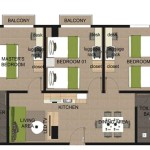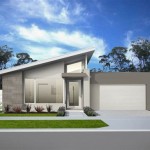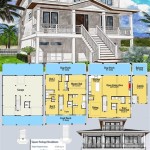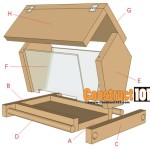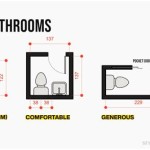Understanding the One Bedroom Floor Plan: A Comprehensive Guide with Dimensions
The one-bedroom apartment or house is a common living arrangement, particularly for single individuals or couples. Its popularity stems from its affordability, manageability, and often, its convenient location near urban centers. A well-designed one-bedroom floor plan can maximize space, promote functionality, and enhance the overall living experience. Understanding these plans, particularly with regard to dimensions, is crucial for prospective tenants, homeowners, and even interior designers seeking to optimize space utilization.
This article delves into the specifics of one-bedroom floor plans, providing a comprehensive overview of their typical dimensions, common layouts, and key considerations for effective space planning. It aims to equip readers with the knowledge necessary to evaluate, design, and make the most of a one-bedroom living space.
Typical Dimensions and Spatial Breakdown
While the exact dimensions of a one-bedroom floor plan can vary significantly depending on location, architectural style, and overall budget, there are some general ranges that are typically observed. The total square footage can range from as low as 400 square feet to upwards of 800 square feet, with an average falling somewhere between 500 and 700 square feet. Within this space, the allocation is typically divided among several key areas:
Bedroom: The bedroom is generally the largest single room in a one-bedroom apartment. A reasonable minimum size for a comfortable bedroom should accommodate a queen-sized bed (60 inches wide x 80 inches long), two bedside tables, and enough space to move around freely. This typically translates to a minimum bedroom size of approximately 10 feet x 12 feet (120 square feet). Larger bedrooms might measure 12 feet x 14 feet (168 square feet) or even larger, allowing for additional furniture such as a dresser, armoire, or reading chair. The critical dimension here is ensuring adequate clearance around the bed for comfortable movement and access to storage.
Living Area: The living area serves as the primary space for relaxation, entertainment, and often, a dining area. The dimensions of the living area are crucial for accommodating essential furniture such as a sofa, coffee table, entertainment center, and potentially a dining table and chairs. A commonly observed size for a one-bedroom living area ranges from 12 feet x 15 feet (180 square feet) to 15 feet x 20 feet (300 square feet). The specific dimensions and shape of the living area will heavily influence furniture arrangement and overall flow.
Kitchen: The kitchen is a critical functional space. In a one-bedroom apartment, kitchens are often compact and efficient. They may be designed as galley kitchens (a narrow space with cabinets and appliances on either side), L-shaped kitchens, or open-concept kitchens that flow into the living area. Regardless of the layout, the kitchen must accommodate essential appliances such as a refrigerator, stove/oven, sink, and potentially a dishwasher and microwave. Countertop space is also a vital consideration. A minimum kitchen size might be around 6 feet x 8 feet (48 square feet) for a very compact galley kitchen, while larger kitchens, especially open-concept designs, could occupy 8 feet x 12 feet (96 square feet) or more. Sufficient aisle space is required for comfortable movement and operation of appliances.
Bathroom: The bathroom is typically the smallest dedicated room in the floor plan. A standard bathroom will include a toilet, sink, and shower or bathtub. The minimal dimensions for a functional bathroom are often around 5 feet x 7 feet (35 square feet). Larger bathrooms may include additional features such as a double sink, linen closet, or separate shower and bathtub, and could measure 8 feet x 10 feet (80 square feet) or larger. Code requirements often dictate minimum clearances around fixtures for accessibility and safety.
Closet Space: Adequate closet space is often a significant factor in the desirability of a one-bedroom apartment. There should ideally be a bedroom closet and a separate entry or utility closet for storing coats, shoes, and other items. The minimum depth for a functional closet is typically around 24 inches to accommodate hanging clothes. The width of the closet will vary depending on the design, but at least 4 feet of width is generally desirable. Smaller apartments may only have one closet shared between bedroom and general storage needs.
Other Considerations: Beyond these core spaces, a one-bedroom floor plan may also include a small entry hallway, a balcony or patio, or a dedicated laundry area. These additional spaces will contribute to the overall square footage and impact the layout and functionality of the apartment.
Common One-Bedroom Layout Variations
While the basic components of a one-bedroom floor plan remain consistent, the arrangement and integration of these components can vary widely. Several common layouts are observed:
Linear Layout: This layout features a linear arrangement of rooms, often with the entry hallway leading to the living area, followed by the kitchen, bathroom, and finally the bedroom at the end of the sequence. This layout is often found in older apartment buildings and can feel somewhat cramped if not well-designed. The advantage of a linear layout is its simplicity and ease of construction.
Open-Concept Layout: This popular layout integrates the living area, dining area, and kitchen into a single, flowing space. The bedroom and bathroom are typically separated from this main living area. Open-concept layouts promote a sense of spaciousness and encourage social interaction. However, they can also require careful planning to define distinct zones within the open space. Noise and odors from the kitchen can easily permeate the living area in an open-concept layout.
L-Shaped Layout: An L-shaped layout features the living area and kitchen arranged in an L-shape, creating a natural separation between the two spaces. The bedroom and bathroom are usually located off of a hallway connected to the living area. This layout provides a good balance between open space and defined areas.
Shotgun Layout: Similar to a linear layout, the shotgun layout features rooms arranged in a straight line, one behind the other. The difference is that the entrance is typically at one end of the apartment, leading directly into the living area. Shotgun layouts can be challenging to furnish and may lack privacy, as one must often pass through one room to access another.
Studio Conversion: Some one-bedroom apartments are actually converted studio apartments, where a wall or partition has been added to create a separate bedroom. These conversions can result in smaller room sizes and potentially awkward layouts. It's important to carefully assess the dimensions and functionality of a converted studio apartment before committing to it.
The choice of layout will depend on individual preferences, lifestyle, and the specific characteristics of the building. Factors such as natural light, views, and noise levels should also be considered when evaluating different layouts.
Key Considerations for Effective Space Planning in a One-Bedroom
Maximizing space and functionality in a one-bedroom apartment requires careful planning and attention to detail. Several key considerations should guide the design process:
Prioritize Functional Furniture: In a limited space, every piece of furniture should serve a purpose. Consider multi-functional furniture such as sofa beds, storage ottomans, and extendable dining tables. These pieces can help to minimize clutter and maximize the use of available space. Wall-mounted shelves and cabinets can also provide valuable storage without taking up floor space.
Optimize Vertical Space: Utilize vertical space to create storage and visual interest. Tall bookshelves, cabinets that reach the ceiling, and vertical wall art can draw the eye upwards and make the space feel larger. Hanging plants can also add a touch of greenery without occupying valuable floor space.
Create Visual Separation: In open-concept layouts, it's important to define distinct zones for different activities. This can be achieved through the use of area rugs, changes in flooring, furniture placement, and even strategic lighting. Room dividers, such as screens or curtains, can also be used to create temporary separation when needed.
Maximize Natural Light: Natural light can significantly enhance the sense of spaciousness and comfort in a one-bedroom apartment. Keep windows clear of obstructions and use light-colored window treatments to maximize the amount of natural light that enters the space. Mirrors can also be used to reflect light and make the room feel brighter.
Maintain a Consistent Color Palette: A consistent color palette can create a sense of harmony and flow throughout the apartment. Light and neutral colors tend to make spaces feel larger, while darker colors can create a sense of coziness and intimacy. Avoid using too many contrasting colors, as this can make the space feel cluttered and disjointed.
Declutter Regularly: Clutter is the enemy of small spaces. Regularly declutter and get rid of items that are no longer needed or used. Invest in storage solutions to keep belongings organized and out of sight. A minimalist approach to decor can also help to create a more spacious and inviting atmosphere.
Consider Traffic Flow: Ensure that there is adequate clearance for comfortable movement throughout the apartment. Avoid placing furniture in ways that obstruct pathways or create bottlenecks. A well-planned traffic flow will make the space feel more functional and less cramped.
By carefully considering these factors and planning accordingly, it is possible to create a comfortable, functional, and aesthetically pleasing one-bedroom living space, regardless of its dimensions.

1 Bedroom Floor Plans

One Bedroom Apartment Home Style 1a Ada Vantage On The Park

1 Bedroom House Plan Examples

House Design Plans 18x21 3 Feet With One Bedroom Flat Roof Samhouseplans

1 Bedroom Traditional House Plan Tr45as Inhouseplans Com

400 Square Foot One Bedroom Cottage 560009tcd Architectural Designs House Plans

Ground Floor Plan Of One Bedroom Bungalow Scientific Diagram

1 Bedroom House Plan Examples

Simple One Bedroom House

1 Bedroom House Plans With Dimension
Related Posts

